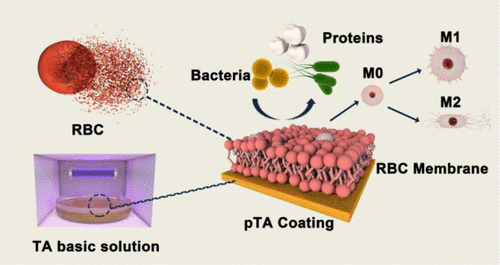当前位置:
X-MOL 学术
›
Chem. Mater.
›
论文详情
Our official English website, www.x-mol.net, welcomes your
feedback! (Note: you will need to create a separate account there.)
A Stable Cell Membrane-Based Coating with Antibiofouling and Macrophage Immunoregulatory Properties for Implants at the Macroscopic Level
Chemistry of Materials ( IF 7.2 ) Pub Date : 2021-10-14 , DOI: 10.1021/acs.chemmater.1c01957 Zhiyun Dong 1 , Xiang Ke 1 , Shuxian Tang 1 , Shuai Wu 2 , Wei Wu 2 , Xingyu Chen 3 , Jiaojiao Yang 4 , Jing Xie 1 , Jun Luo 1 , Jianshu Li 1, 4, 5
Chemistry of Materials ( IF 7.2 ) Pub Date : 2021-10-14 , DOI: 10.1021/acs.chemmater.1c01957 Zhiyun Dong 1 , Xiang Ke 1 , Shuxian Tang 1 , Shuai Wu 2 , Wei Wu 2 , Xingyu Chen 3 , Jiaojiao Yang 4 , Jing Xie 1 , Jun Luo 1 , Jianshu Li 1, 4, 5
Affiliation

|
Conventional orthopedic/dental implants can trigger foreign body reactions and are vulnerable to biocontamination because of the lack of suitable surface functions from natural biointerfaces, which may lead to inflammation, infection, and subsequent poor osseointegration and implant failure. Instead of attempting to synthetically replicate the sophisticated biointerface properties, directly utilizing natural cell membranes to bestow implant surfaces with integrated functions is a promising strategy to avoid implant failure. This study presents a facile general strategy for fabricating a controllable (patterned) and bioactive cell membrane-based coating for orthopedic/dental implants at the macroscopic level by leveraging a polyphenol layer (poly(tannic acid)) as an intermediate to bind the cell membranes to the implant surface. The poly(tannic acid) layer provides significant immobilization and stability for the cell membrane layer on the implant surface. This homogeneous cell membrane-based coating presents excellent antibiofouling capabilities, which can effectively prevent the nonspecific adsorption of model proteins (bovine serum albumin, fibrinogen, and lysozyme) and bacteria (Escherichia coli and Staphylococcus aureus). Additionally, it exhibits excellent biocompatibility and macrophage immunoregulatory capacity and can potentially decrease the risk of implant infection. This technique can be applied to diverse cell types and implants for better implant integration because of the high cell affinity of polyphenols.
中文翻译:

具有抗生物污损和巨噬细胞免疫调节特性的稳定细胞膜基涂层,用于宏观水平的植入物
传统的骨科/牙科植入物会引发异物反应,并且容易受到生物污染,因为天然生物界面缺乏合适的表面功能,这可能导致炎症、感染以及随后的骨整合不良和植入物失败。与其试图合成复制复杂的生物界面特性,不如直接利用天然细胞膜赋予植入物表面以集成功能,是避免植入物失败的有前景的策略。这项研究提出了一种简单的通用策略,通过利用多酚层(聚(单宁酸))作为结合细胞膜的中间体,在宏观水平上为整形外科/牙科植入物制造可控(图案化)和生物活性细胞膜基涂层到种植体表面。聚(单宁酸)层为植入物表面的细胞膜层提供了显着的固定和稳定性。这种均质的细胞膜基涂层具有优异的抗生物污染能力,可有效防止模型蛋白(牛血清白蛋白、纤维蛋白原和溶菌酶)和细菌的非特异性吸附。大肠杆菌和金黄色葡萄球菌)。此外,它还具有出色的生物相容性和巨噬细胞免疫调节能力,并有可能降低植入物感染的风险。由于多酚的高细胞亲和力,该技术可应用于不同的细胞类型和植入物,以实现更好的植入物整合。
更新日期:2021-10-26
中文翻译:

具有抗生物污损和巨噬细胞免疫调节特性的稳定细胞膜基涂层,用于宏观水平的植入物
传统的骨科/牙科植入物会引发异物反应,并且容易受到生物污染,因为天然生物界面缺乏合适的表面功能,这可能导致炎症、感染以及随后的骨整合不良和植入物失败。与其试图合成复制复杂的生物界面特性,不如直接利用天然细胞膜赋予植入物表面以集成功能,是避免植入物失败的有前景的策略。这项研究提出了一种简单的通用策略,通过利用多酚层(聚(单宁酸))作为结合细胞膜的中间体,在宏观水平上为整形外科/牙科植入物制造可控(图案化)和生物活性细胞膜基涂层到种植体表面。聚(单宁酸)层为植入物表面的细胞膜层提供了显着的固定和稳定性。这种均质的细胞膜基涂层具有优异的抗生物污染能力,可有效防止模型蛋白(牛血清白蛋白、纤维蛋白原和溶菌酶)和细菌的非特异性吸附。大肠杆菌和金黄色葡萄球菌)。此外,它还具有出色的生物相容性和巨噬细胞免疫调节能力,并有可能降低植入物感染的风险。由于多酚的高细胞亲和力,该技术可应用于不同的细胞类型和植入物,以实现更好的植入物整合。










































 京公网安备 11010802027423号
京公网安备 11010802027423号